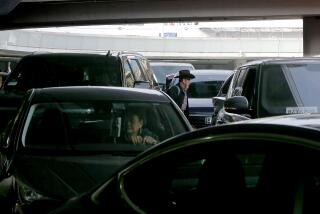Opinion: Has the new Expo Line been doomed to slow, mediocre service before it even opens?
The Expo Line extension to Santa Monica starts its official roll Friday, and while there is lots of excitement over an alternative to the dreadful 10 Freeway commute, some transit advocates are pressuring the city of Los Angeles to use traffic signals to help speed up the train.
The problem is that L.A.’s newest rapid transit line isn’t rapid enough. The 15-mile ride from downtown Los Angeles to Santa Monica will take about 46 minutes.
Advocates say Metro could shave a couple of minutes off the travel time if the Los Angeles Department of Transportation gave the trains signal preemption at more intersections. That’s when the approaching trains trigger a signal change to green so they don’t have to stop at the intersection.
The L.A. Weekly reported last month on the Expo Line sluggishness, prompting a change.org petition urging the LADOT to give priority to trains over cars. The petition calls on city officials to give signal preemption to Expo trains in downtown Los Angeles and “give priority to a three-car train, with maybe 250 people on it, rather than sitting and waiting for vehicle traffic, which carries 1 or 2 persons per car.”
Their frustration is understandable. The new section of the Expo Line from Culver City to Santa Monica is speedier than other light rail lines because the train is grade separated for long stretches and doesn’t have to slow for traffic. When the train is at ground-level, many of the grade intersections have signal preemption and gates installed so cars wait while the train speeds by.
The problem is the first phase of the Expo Line from downtown Los Angeles to Culver City wasn’t similarly designed. That section, for the most part, is at grade and it has many intersections without gates or preemption. Trains have to follow the same rules as cars, and often have to sit at traffic lights. As a result, the eastern section of the line can feel pretty slow.
The LADOT has worked closely with Metro to synchronize the signals so that trains running on schedule should mostly hit green lights. And the trains have signal priority – that is, they can hold a signal green for a couple of extra seconds to make it through the intersection. That helps. But the problem is the synchronization schedule doesn’t account for real-life incidents that slow the trains so they miss the green lights.
But signal preemption in and around downtown may be difficult, if not impossible. The Expo Line merges with the Blue Line and there are intersections where trains pass through about every three minutes. Preemption would mean practically shutting down those intersections, Metro and LADOT officials said.
So, are Expo Line riders doomed to slower-than-desired travel? Not necessarily. LADOT officials said they’ll fine-tune signal priority once the Expo extension is up and running. When the Regional Connector is completed in 2020, that should alleviate some of the slowness downtown. The long-term answer, however, is grade separation. Trains can run faster and more safely and stay on schedule if they don’t have to cross paths with drivers, pedestrians and cyclists. (KPCC-FM (89.3) analyzed Metro data and found that, no surprise, the underground subway lines have the fewest delays.)
Of course, it’s more expensive to build grade-separated rail or to retrofit an existing system. An overpass can cost as much as $20 million, one official estimated. But as L.A.’s rail system expands in an increasingly dense, traffic-clogged urban area, it’s penny-wise and pound-foolish to build lines that have to stop at red lights and share the road with cars.
The good news is that Angelenos are demanding better, faster public transit from their elected officials. As of Friday, the petition for preemption had about 1,160 signatures, and public awareness will likely increase after the extension opens next week. In years past, folks might have been content to accept red lights and long travel times because, hey, slow light rail is better than no light rail. But the bar should be higher, and fast, convenient service should be the priority -- especially if voters are expected to pass another half-cent sales tax in November to build even more rail.
MORE LIVABLE CITY:
How L.A. can improve its return on our multibillion-dollar transit investment
What do we do with the Silver Lake reservoirs?
Is L.A.’s housing market really as unaffordable as it seems?
Twitter: @kerrycavan
More to Read
A cure for the common opinion
Get thought-provoking perspectives with our weekly newsletter.
You may occasionally receive promotional content from the Los Angeles Times.







